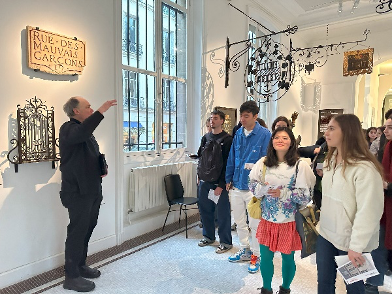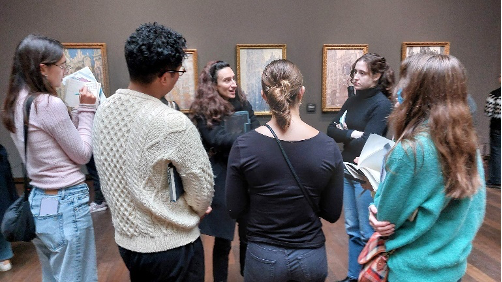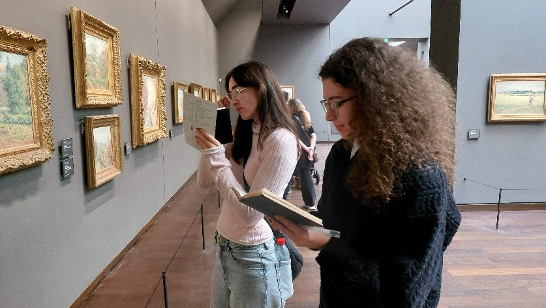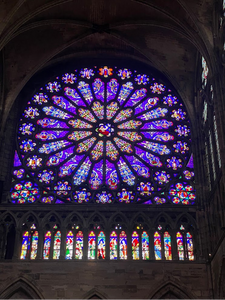I LOVE PARIS IN THE …WINTER: The Art History Paris Fieldwork Experience!
- donnabrett8
- Aug 6, 2024
- 6 min read
Written by Mark Ledbury and Victoria Souliman
The Art and the City: Fieldwork Unit is offered through the Discipline of Art History. and was generously assisted by student travel scholarships from the Frank McDonald Memorial Fund. This scholarship supports student access and inclusive educational opportunities.
This was an exceptional opportunity and absolutely crucial for my degree.
Since we began the exciting venture of Fieldwork unit (ARHT3681: Fieldwork: Art and the City) we’ve taken groups of final year undergraduates to Paris or Berlin for a two-week, intensive experience of museums, monuments, architecture and the urban fabric. In 2024, unusually, the course ran in the Summer School period (and thus in the European Winter!), but the weather was kind to us and all we needed was to wrap up warm and enjoy the glorious winter sunshine!
The trip was led by Professor Mark Ledbury, (Power Professor of Art History and a specialist in the art of Early Modern Europe), and Dr Victoria Souliman, (from the Department of French and Francophone Studies), whose expertise is in twentieth-century and contemporary art, and whose Parisian know-how came in very handy!
The Itinerary for the two weeks of visits and discussions was a packed one, and began with the extraordinary architectural and cultural riches of the Louvre, an exhausting but exhilarating engagement from the Colonnade to the Pyramid to the Raft of the Medusa, the Marie de Medicis cycle, an almost deserted room full of Rembrandt masterpieces, David’s great History paintings and even an Italian portrait whose name escapes me…
Victoria Souliman leads discussion of Haussman’s Boulevards and the Opéra Garnier
I have enjoyed the deeply communal aspect of this overseas intensive ... the access to incredible resources during the trip has been unlike anything I could experience on-campus and I have cherished that experience.
Students gathered and taking notes on the Architecture of the Louvre
Day two brought us to the recently renovated and fascinating Musée Carnavalet – the city of Paris history museum, after a walk through the Marais district to discuss the development of Paris’s neighbourhoods and great urban squares, including the Place des Vosges.
In the afternoon, we explored the Petit Palais museum, an unexpected and undervisited museum, built for the great exhibition of 1900 and dwarfed by its neighbour, the Grand Palais, but in fact a beaux-arts style gem, with a fascinating, eclectic collection ranging from 8th century icons to Courbet’s much controversial painting The Sleepers . The Petit Palais also hosted a show about Parisian modernity, which students got to explore.
Seeing art works up close and learning on the field was important for my education in art history.
Fernand Pelez’s Grimaces and Misery attracted the students’ attention at the Petit Palais
Wednesday was medieval day, and was begun with a trip to the ever-extraordinary Sainte Chapelle – a jewel-box and one of the finest examples of gothic stained glass anywhere in the world. We also visited the newly remodelled Cluny Museum, itself full of medieval treasures, including the wonderful Lady and the unicorn tapestries.
Students in awe of the magnificent stained glass work at the Sainte Chapelle (Upper Chapel)
Carnavalet Museum, the Musée d’Orsay and the Orangerie
The friendships formed during this unit created an atmosphere of excitement and intrigue into Paris and French art. I am grateful for this trip and the opportunities to explore the city with an incredible group and fantastic teaching team.
On Day four, we visited the Musée d’Orsay. Our early entry time meant we had some moments almost alone among the (arguably) greatest collection of impressionist and post-impressionist paintings in the world. Some students opted to view masterpieces by Manet, Monet, Degas, Cassatt and Morisot, while others ventured into the Van Gogh: The Final Months exhibition.
Continuing our focus on late nineteenth-century art in the afternoon, the students visited the extraordinary ensemble of paintings created by Claude Monet for the Orangerie in the Tuileries – the famous Water Lilies.
On the Friday (Day 5) students took advantage of a choice of venues, with a tour of the Opera Garnier illuminated by the expertise of Victoria Souliman followed by visits to less well-known spaces from the Gustave Moreau Museum to the Musée Montmartre.
Victoria Souliman presents the opulent splendour of the Opera Garnier, and the Basilica of Saint-Denis.
Our fifth day was rounded off with a seminar at which we discussed the week, in the seminar rooms of the INHA (Institut National d’Histoire de l’Art) in Paris, and planned the group presentations for the following week. The presentations are part of a very varied assessment for the unit which included an introductory quiz and the ‘reflective journal’, (the result of the active note taking you see evident in many of these photographs). After the seminar we took over a trendy bar near Les Halles for a very fun and well-deserved social gathering!
Students relax after our first seminar on Friday.
Saturday was excursion day outside Paris, and saw us in the gothic splendour of the Basilica Saint Denis as well as in the exquisite and time-warpy setting of the Musée Condé at Chantilly. Some students braved the rain and mud to walk the splendid gardens and Grandes Écuries, while most stayed inside to explore the unique and uniquely displayed collections of the Duc D’Aumale, which includes works by Poussin, Ingres and Raphael that never leave France.
The unique hang and extraordinary collections of the Musée Condé Chantilly
A wintry view of the Chateau / Musée Condé
Sunday was a rest day for the students and then, on Monday, to kick off the second week of the trip, we explored modern and contemporary art and architecture at the Bourse de Commerce (renovated and leased to the Pinault Foundation) and the Centre Pompidou - which is due to close soon for important structural renovations.
On Tuesday, we delved into the controversial museography of the collection of non-western art of the Musee du Quai Branly-Jacques Chirac. The visit provided students with an opportunity to reflect on France's colonial history while also learning about the museum's mission to preserve, document, and share its collection with other institutions, including many in the Oceania-Pacific region.
Victoria Souliman discusses with students the architecture and history of the Musée du Quai Branly – Jacques Chirac
And then we split into smaller groups to explore a range of museums, including the Musee d’art moderne de la Ville de Paris, where students immersed in Raoul Dufy’s huge fresco La Fée électricité, Sonia and Robert Delaunay’s abstract paintings, and Henri Matisse’s mural designs for La Danse.
This unit has been incredibly rewarding in offering a real-world experience of art history. The balance of extensive knowledge from Mark and Vic and encouragement to make our own observations. The exposure to really varying sites. It gave an indication of what a career in art history could be.
Students among the orphic cubism shapes and colours of the Musée d’’Art Moderne de la Ville de Paris
The following day, we headed out to the exhausting, elaborate and historically fascinating site of the Chateau of Versailles, wandering the extravagant palace of the Bourbons and exploring the beautiful Petit Trianon and Marie-Antoinette's hameau.
Thursday, saw the students engage with Frank Gehry’s architecture and Rothko’s painting at the Fondation Louis Vuitton.
Up close with Rothko at the Fondation Louis Vuitton, Students inhabit Gehry’s extravagant architecture at the Fondation Louis Vuitton and the Catacombs - Stop! -- This is the empire of Death and group photo at Versailles
On Friday, our last day, we had the rare opportunity to visit one of Paris’s most ‘underground’ attractions—the Catacombs, the miles of former quarry tunnels filled with bones brought from the cemeteries of Paris whose insalubrity had endangered the health of Paris in the eighteenth century.
The rest of the day was spent finalising and presenting the group projects, that students preparedon the basis of themes they’d explored across the various museums and sites they had visited during the trip. The students produced wonderful and thought-provoking work and responded with imagination to the challenges the presentations posed.
Students present their ideas in our final seminar and farewell dinner
And then after all that hard work, we celebrated with a farewell dinner – and exhausted though we all were, the fun and the bonding and the exploration that make up the heart of the trip were very much the vibe among the group.
The students not only produced excellent presentations, they also filled out reflective journals that chronicled their learning experiences, and revealed the depth of their engagement with the monuments of Paris. Students had some very generous thoughts on the unit, expressed both at the time and in the Unit of Study feedback.













































Comments